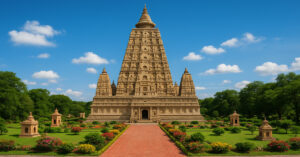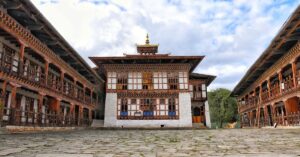Nabji Lhakhang is a one-story temple built by Khandro Tashi Khyidren at the site of Guru Rinpoche. The Nabji Lhakhang is located in Nabji village, Korphu Gewog, under Trongsa Dzongkhag at an elevation of 1,312 meters.
This is the place where Guru made peace between the two kings, Sindhu Raja and Nawoche, by erecting a stone pillar of oath (Nado). A stone pillar of the oath still stands inside the temple as the main relic with the handprints of Guru Rimpoche, King Sindhu Raja, and King Nawoche.
Trongsa Nabji Lhakhang is popular for the annual Nabji Lhakhang Drup, similar to Jambay Lhakhang Drup.
How to Reach Nabji Lhakhang
To visit the historic Nabji Lhakhang, drive till the road ends at Nabji Primary School. The school is 115 km away from Trongsa town. From the school, hike up for half an hour to reach the sacred Nabjee. If you are an ardent trekker, you can also reach Nabji from Reotala, between Trongsa and Zhemgang. Consider planning the Nabji Korphu trek if you would like to enjoy Bhutan’s scenic, traditional rural life.
Sacred Relics to See at Nabji
- A stone pillar of the oath with the handprints of Guru Rinpoche, King Sindhu, and King Nawoche inside the temple symbolizes the Dakinis’ Mind;
- The rock that represents the Dakinis’ Body;
- The rock that represents the Dakinis’ Speech with graffiti is believed to be the Dakini’s symbolic script (Khandro Dayig);
- A stone with fingerprints of Khandro Tashi Khyidren;
- A rock bearing the footprints of Dorje Lingpa and his horse;
- An annual Nabji Lhakhang Drup is known as Doling Drubchen.
Also Read: Guru Rinpoche in Bhutan: His Visits to Bhutan and Sacred Sites
Historical Significance of Nabji
The history of Nabji dates back to Guru Rinpoche’s first visit to Bhutan. It is said that Guru Padmasambhava persuaded King Nawoche of Assam, India, to come with him to the border to make peace with King Sindhu Raja of Bumthang, Bhutan.
At the present-day Nabji Korphu village border, Guru Rinpoche made peace between the two kings who constantly fought for various reasons, especially the border issues. He gave the teachings and made them take an oath to live in harmony. A stone pillar of oath (Nado) was erected as a border demarcation, and they took vows to never infringe on the border and to live in peace.
Also Read: 2 Holiest Sites Blessed by Guru Rinpoche During His First Visit to Bhutan
Thus, the place got its name, Nathang, the place of oath. Later, it became Nabji at the southern end of the Mangdechhu Valley. Guru Rinpoche has also blessed the Nabjee area as a Beyul (hidden land) by hiding many treasures. Nabji is surrounded by many significant places, such as Ku Drak to the north at a 30-minute walk, Jowo Durshing to the west at a distance of 1 day’s walk, Korphu to the south, and Sharphu to the east. Nearby places are Potala, and below Potala are Reti and Neythang towards Sarpang. Guru Rinpoche is said to have taken this route while traveling to Bumthang Kurjey from Draphu Maratika, Nepal.
Ku Drak
After the oath-taking was over, the kings returned to their respective places, while Guru went to Ku Drak for a night and subdued the demons of Ugyen Drak. On arriving at Ku Drak, a man, knowing it was Guru Rinpoche, offered some beaten rice from a tube. From its merits, the man became wealthier and renowned as the Ku Drak Chup, the rich man of Ku Drak.
On Guru Rinpoche’s second visit to Ku Drak, the man had become so rich that his wealth was in excess, and he had difficulties managing it. He requested Guru for an idea to reduce it, to which Guru told him to sit on the same seat as him and keep his cup on the same table. The man did so. Gradually, the man’s wealth diminished to the extent that even his house fell into ruins.
Later, when Guru Rinpoche visited Ku Drak, the man requested Guru to make him rich again. Guru said, “You didn’t want to be rich. Now, you don’t want to be poor. Now, use your mouth and hands for daily living”. True to this, today, the people of Ku Drak, aka Monpa, make their livelihood through can (bamboo) works (Tsharzo, which requires using both hands and mouth). Having his virtue degraded, the once-rich man of Ku Drak eventually perished without even leaving a descendant. The ruins of his house can still be seen.
Description of Nabjee
There is a tree near the entrance that is thought to be Guru Rinpoche’s walking stick. A box containing the souls of the local protective deities can be found in the chapel’s left corner, alongside statues of Pekar Gyalpo, the community’s main protective deity, the Black Mountains deity Jowo Durshing, the protective deity of Kurtoe Terdag Zorarakye, and Muktsen, the Mangde region’s protective deity.
A rock bearing the footprints of Dorje Lingpa and his horse lies on the temple’s right edge, near the windows. A stone connected to the wall on the right side of the temple carries the fingerprints of Khandro Tashi Khyidren.
There are two sacred rocks. The upper rock represents the Dakinis’ Body, and the lower rock represents the Dakinis’ Speech. A stone pillar inside the temple symbolizes the Dakinis’ Mind. The graffiti on the sacred Dakinis’ Speech rock is believed to be the Dakini’s symbolic script (Khandro Dayig).
Nabji Temple
Khandro Tashi Khyidren, the daughter of King Sindhu Raja, built the Nabji Lhakhang on the sacred place of Guru Rinpoche. During the construction, it is said that the temple blocks constructed during the daytime were destroyed in the evening by demons and evil spirits. Frustrated by the repeated destruction, Khandro Tashi Khyidren prayed for the Guru’s help. Even though Guru Rinpoche was not there at the time of the building, Khandro could see him by facing the cliff, where Guru Rinpoche is supposed to have concealed numerous spiritual treasures.
Guru Rinpoche distracted demons and evil spirits by performing a sacred naked dance (Tercham), displaying many forms, such as half-human and half-animal. The Khandro completed the temple while demons and spirits were distracted by Guru Rinpoche. The tradition of performing Terchham is said to have originated from this event at Nabji Lhakhang.
Nabji Lhakhang is a one-story traditional Bhutanese temple with a wall around it. The old wall of Nabji temple, constructed by Khandro Tashi Khewdren, measures approximately 8m sq. and 4m high; the rest was built through the Guru’s miracles. That is why the wall is so unique. The temple was consecrated by Terton Dorje Lingpa in the 13th century.
Nabji Lhakhang
Later in the 19th century, the patron Tashi Wangdi from Bumthang extended the temple to its present structure. The main relics of Nabji Lhakhang are the Pillar of Oath, considered a mind relic (Thukten), the Dakini scripts as the speech relic, and the piled stones outside the temple as the body relic.
The front wall of the temple has the paintings of Dorje Lingpa, Pema Lingpa, and their lineage holders, as well as Chagzampa Thangtong Gyalpo and Green Tara, painted by a man named Lhalung Choki Wangchuk from Tibet.
The Four Guardian Kings statues are attached to the exterior walls of the inner chapel on the right side of the entry: two kings on each wall, with the entrance to the inner altar in the center. The Eight Manifestations of Guru Rinpoche, Zhabdrung Ngawang Namgyal, the great Kagyu saints Marpa and Milarepa, and the Three Long Life Deities are painted on the chapel’s left-side wall. It was painted by a man named Tawdola from Guru Lhakhang, which is half a kilometer away from Tamzhing Lhakhang in Bumthang.
Trulku Chogden Gonpo is claimed to have sculpted a figure of Guru Rinpoche on the inner altar. On Guru Rinpoche’s left are statues of Chenrezig (Avalokiteshvara), Chagtong Chentong (Avalokiteshvara with a thousand eyes and arms), Chana Dorje (Vajrapani), Future Buddha Jowo Jampa, and Terton Dorje Lingpa, which is reported to have been made by Trulku Chogden Gonpo himself.
There are statues of Zhabdrung Ngawang Namgyel, the deity of wealth Zambalha, and Buddha Sakyamuni on Guru Rinpoche’s right side. A figure of Menmo, the local water god, is in the right-hand corner of the inner altar.
Nabji Lhakhang Drup
The villagers support an annual Nabji Lhakhang Drup from the 15th to the 20th day of the 11th month of the Bhutanese calendar. The Drup of Nabji Lhakhang is claimed to be identical to the Jambay Lhakhang Drup of Bumthang. It is a five-day event during which the monks and local villagers of Nabji, also known as Doling Drubchen, perform Pema Lingpa’s Terchams, or naked dances. The festival includes Meywang, Peling Gimsum Chams, Tshogyem, Pholay Molay dance, Tercham-Naked Dance, and other dances. The Drup concludes with the display of Guru Tshengye’s Thongdrel.
Best Time to Visit Nabji Lhakhang
You can visit Nabji Lhakhang at any time of the year. However, visiting Nabji during the annual Nabji Lhakhang Drup, conducted from the 15th to the 20th day of the 11th month of the Bhutanese calendar, would be a bonus. You can witness a five-day festival where the monks and the local villagers of Nabji perform the naked dances (Terchams) of Pema Lingpa. You can visit the major pilgrimage sites of Trongsa with the Bhutan Pilgrimage Package.
Places to Explore in Trongsa
Trongsa Dzong: It is Bhutan’s largest fortress, majestically overlooking the Mangde River valley. Built in the 17th century, it served as a strategic military and administrative center. Renowned for its intricate architecture and historical significance, the dzong played a crucial role in Bhutan’s unification and remains a symbol of royal heritage.
Ta Dzong (The Tower of Trongsa Museum): Built in 1652 by Chogyal Minjur Tempa, the first Governor of Trongsa, it is a historic watchtower overlooking Trongsa Dzong. It features four observation points shaped like a Tiger, a Lion, a Garuda, and a Dragon. Converted into the Royal Heritage Museum in 2008, it showcases Bhutan’s monarchy, royal artifacts, and Buddhist relics across eleven galleries.
Tsheringma Drupchhu: It is a holy spring believed to be blessed by the goddess Tsheringma. Drinking or bathing in its water is said to enhance longevity and grant a melodious voice, especially if it’s the first water a child drinks. It also holds spiritual and medicinal significance.
Chendebji Chorten: It is a stupa built in the 18th century modeled after Nepal’s Swayambhunath. The whitewashed Chorten symbolizes peace and protection.
Kuenga Rabten Palace: Built in 1929 near Trongsa, it served as the winter residence of Bhutan’s second King, Jigme Wangchuck. This two-story Bhutanese-style palace features traditional architecture, a temple, and royal apartments. It now functions as a monastery and cultural site, preserving royal history and hosting monks.
Enjoyed reading this blog?




